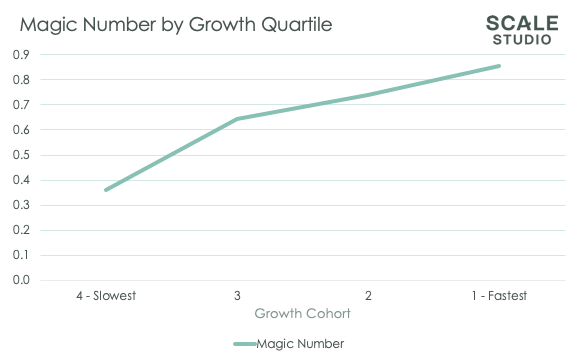No single metric tells you exactly when to step on the gas and scale, scale, scale. Getting the timing right is hard and one of thorniest decisions founders make in the early going. There’s no cookie cutter answer either, but you can do better than just guess by understanding the link between Growth and Sales Efficiency.
Intuition tells you that spending more on Sales & Marketing should increase growth (and burn rate) but lower your Sales Efficiency metrics (more dollars in the numerator). Growth and Sales Efficiency are a trade off: you spend more to grow more.
To test that intuition, Scale analyzed more than 2,000 quarterly data points on SaaS startups from $1M to $200M in ARR asking: When is the right time to go all-in on scaling your business?
Quite surprisingly, our analysis found that:
Faster growing companies have HIGHER Magic Numbers than their lower-growth counterparts.
What gives? The answer is lengthy (though informative!) and comes down to this: the highest-performing companies have a flywheel effect at work. It’s so powerful that it lifts both Growth and Sales Efficiency at the same time.

High-growth companies are high growth because they find product-market fit, target a large addressable market, hire the right people throughout the company, and so on. That lets them raise capital more easily, and more of it. Which in turn means they can continue to invest in Sales & Marketing operations and talent. Which does in fact create more growth.
The lesson from our analysis is that you shouldn’t rush to scale until you’re sure that your Sales & Marketing engine will generate the highest possible level of new sales growth. If you’re seeing your Magic Number and other metrics bounce around quarter to quarter, it’s probably too early to step on the gas. But when the flywheel starts turning, go for it.
There’s a lot to know about sales efficiency metrics. Start here: